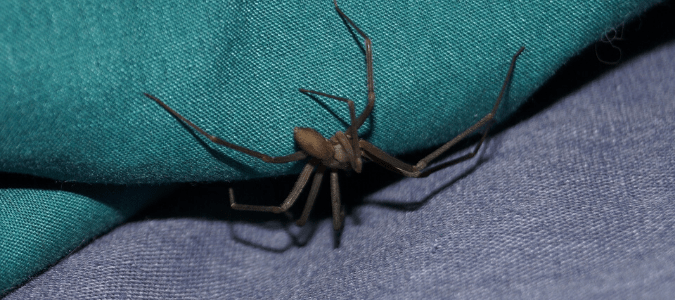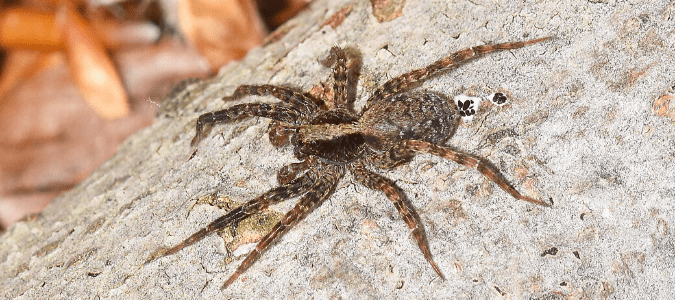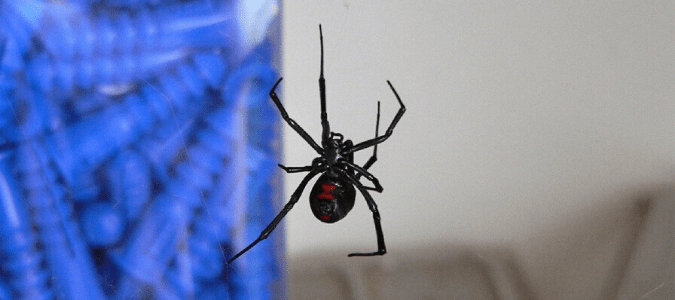
You may be anxious after finding a brown spider in or around your home. After all, you know that brown recluses are native to the area and a bite from one of these spiders can be dangerous. That said, you’ve also heard about wolf spiders. Wondering which type you have spotted? There are a few major differences between a brown recluse and a wolf spider that can help you properly identify which is which, including:
- The size. A wolf spider is shockingly large, growing up to an inch and a quarter in length. Meanwhile, the brown recluse is rarely larger than three-quarters of an inch.
- The appearance. As its name suggests, the wolf spider is hairy, with a fuzzy or furry appearance. In contrast, the brown recluse spider has smooth body parts.
- Markings. The wolf spider has a pattern on its back with multiple colors, most commonly stripes, whereas the brown recluse is just one shade of brown.
Being able to differentiate between these two spiders is extremely important, since the brown recluse spider is one of two spider species in the U.S. that is venomous enough to cause serious harm. On the flip side, you may be surprised to learn that the wolf spider, despite its intimidating looks, has weak venom and is essentially harmless.
Let’s go into a little more detail about both types of spiders so that you know more about the habits and behavior of the creatures that might be making your home theirs.
Brown Recluse Spiders: What You Should Know
The brown recluse is one of the most dangerous spiders in the U.S. Brown recluse spider bites are uncommon, but their bite is at best extremely painful and at worst deadly. Brown recluse bites will sometimes lead to flesh necrosis, especially in the very young or very old. These spiders can be found throughout the south-central United States and in the Midwest.
A brown recluse is, on average, about the size of a nickel or a quarter. As we have already mentioned, the bodies and legs of these spiders are smooth. Despite their name, brown recluses can be light brown, dark brown and even a blackish-gray color. Unlike most spider species, the brown recluse only has six eyes, but this is hard to notice unless the spider is dead. The biggest giveaway for a brown recluse spider is the violin-shaped mark on the front half of its body. These markings help explain the brown recluse spider’s other common names, including the fiddleback spider and brown fiddler.
Because of the risk these spiders pose, to be on the safe side, do not try to identify what could be a brown recluse. Instead, try to catch one of these spiders in a sticky trap to identify it. Better yet, contact a trusted pest control professional to confirm what type of spider is on your property.
Learning more about a brown recluse’s preferred habitat can help you avoid them. The first thing you should know is that these spiders don’t build webs. Rather than waiting for food to become ensnared in a web, a brown recluse actively hunts its prey. This means that spiderwebs aren’t usually a sign of brown recluse activity. This variety of spider prefers dry, undisturbed places, including woodpiles or even footwear left outside. In fact, one of the most common ways homeowners are bitten is when a person unknowingly slips on a shoe with a spider inside. When trapped or pressed against the skin, a brown recluse is very likely to bite.

Wolf Spiders: Terrifying, But Timid
Despite the fact that wolf spiders look much more dangerous than brown recluses, these creatures are mostly harmless. Wolf spiders are large and furry with a patterned back. Wolf spiders are more widespread than brown recluses, as they can be found almost everywhere.
While wolf spiders, like all types of arachnids, do have venom, this poison is relatively weak. Instead of days of swelling, pain and potential death or gangrene, which victims can experience after brown recluse bites, wolf spider bites feel more like bee stings or other insect bites. The bite location may hurt for a few minutes and can remain itchy for several days.
The most common place to find wolf spiders is within dense vegetation or leaf-litter as they commonly burrow into these materials. Wolf spiders prefer natural environments, where they can easily blend in. These spiders typically like to use pre-existing holes or burrows for homes. Small animal burrows, cracks in building foundations or well-protected places in thick bushes are all perfect homes for the wolf spider.
Unlike other types of spiders, wolf spiders are very caring mothers. Females carry their eggs right on their backs, and even let their young live on their backs after hatching. If you find a wolf spider on your property that appears to have a sac on its back, be extra cautious. Wolf spiders carrying eggs may be more aggressive.
Wolf spiders are nocturnal, so you’re more likely to run into these creatures after dark. People often spot wolf spiders with a flashlight because their eyes shine in the light. Keeping your home and yard well-maintained can make your property less attractive to wolf spiders.
Once you know the difference between these two common types of spiders, you may have other questions about common arachnids. In this post, we’ll review other spiders to watch out for, what preys on brown recluses and how to control brown recluses on your property. First, we’ll answer a common question about how wolf spiders get around.
Do Wolf Spiders Jump?
One of the reasons wolf spiders are so frightening is because of their ability to jump. These spiders didn’t just get their name because they are fuzzy. These spiders have a similar predatory behavior as wolves. These spiders are fast runners with keen eyesight. Once a wolf spider has located its prey, it will pounce on its meal, bite down and inject venom. Although this venom doesn’t have much of an impact on humans, it can liquefy the internal organs of grasshoppers, earwigs, crickets and cockroaches, making them easier for the spider to eat.
In addition to wolf spiders, there is another family of arachnids that attacks its prey in a similar fashion: jumping spiders. Like wolf spiders, jumping spiders are not considered dangerous to humans and will rarely bite, unless they are held or feel threatened.
Now that you are more familiar with the brown recluse and wolf spider, let’s discuss the other spider species which has venom strong enough to impact humans: the black widow.

Black Widow vs. Brown Recluse
The black widow is an iconic spider. As you can see in the image above, this arachnid is a glossy black color with a red hourglass pattern on its stomach, although markings can also appear tan, orange or white. This variety of spider is about the size of a dime, and hard to mistake for any other spider. Because it is so venomous, a black widow doesn’t need camouflage. Instead, these distinct colors serve as a warning to scare off potential predators. While a bite from a black widow can be fatal, this is a rare occurrence. While initially painful, other symptoms of a bite include muscle cramps and more severe pain. Washing the impacted area well with soap and water is generally recommended. Doctors may recommend victims get a tetanus shot.
A black widow spins webs that appear messy and tangled. These spiders prefer sheltered spots, including near brush or wood piles, in undisturbed corners of garages and inside boots and gardening gloves.
The brown recluse, as we have already mentioned, is a little larger than a black widow and a glossy brown color. Unlike black widows, a brown recluse hunts its prey at night. While a black widow is striking, a brown recluse looks like a rather ordinary spider. If you’re not sure whether a spider is a black widow, it probably isn’t. It’s much easier to mistake a brown recluse for something else. If you believe you have one of these spiders living on your property and you’re considering when to hire a pest control professional, sooner is always better than later.

What Eats Brown Recluse Spiders?
In the wild, brown recluse spiders have a number of natural predators, including:
- Wolf spiders
- Crickets
- Praying mantis
- Robins
- Wrens
- Chickens
- Spider wasps
- Centipedes
While these animals are helpful if you have brown recluse spiders on your property, they aren’t a cure-all. Brown recluse spiders are very good at hiding, and their small size makes it difficult for many predators to get to them. In addition, you likely don’t want wolf spiders, robins or centipedes in your home either, if you are considering “natural” pest control methods. In most situations, your best bet is to enlist the help of the professionals. Specially-trained pest technicians can help you figure out whether you’re dealing with venomous spiders and recommend an effective treatment plan, based on your goals.

How To Get Rid Of Brown Recluse Spiders
Most homeowners let the professionals recommend a course of action to protect their families from harmful types of spiders. However, if you want to try the do-it-yourself route first, make sure to take precautions so you don’t get bitten. When you’re cleaning out potential brown recluse hideaways, always wear gloves and long sleeves. Thicker materials provide more protection. Use a flashlight when inspecting spaces for spiders. Brown recluse spiders are naturally hard to notice, and these spiders prefer shadowy places. A flashlight can help you see a spider before you get too close.
Be cautious when reaching into crevices or cleaning out clutter. Boxes, shoes and infrequently-used furniture can all serve as homes for brown recluses. Remove items carefully and shake out objects where spiders might be hiding if you want to try to move a spider to a sticky trap to have a pest technician identify later.
Practice Prevention
Once you’re properly outfitted for the task at hand, inspect your property and remove potential hiding spots and food sources.
Inside, focus on storage spaces and rarely used parts of the house. Garages, attics and air ducts are all common places for brown recluse spiders. If you have stacks of boxes or packed closets, you can look through these and clear out any clutter. If you do see a spider, you can use a vacuum to remove it from the area without risking getting bitten. Make sure you also remove any dead insects you find so the spiders don’t have that food source available.
Outside, you’ll want to keep your yard well-maintained to make your environment less attractive to these creatures. These spiders prefer natural hiding spots. Getting rid of brush and leaf litter around your property can help prevent a number of pests from sticking around your property, which can also give spiders fewer reasons to stick around.
Set Traps
Once you’ve cleaned out the places these spiders might live, you can set out traps to monitor activity and catch any spiders that may be in these undisturbed areas. Brown recluse traps are usually sticky pads left in dark, unused corners. The spiders stick to the traps and won’t escape to pose a danger to someone in your household.
Seal Entry Points
Spiders and other insects take advantage of cracks and crevices to find their way inside our homes. Walk around the perimeter of your home and look for any of these spots that might provide a spider with an entry point. When you find one, seal it up. This will not only prevent brown recluse spiders, but can also help prevent other crawling insects, such as termites and ants, from becoming a problem.
Consider Treatment Measures
There are several types of treatment solutions that can be effective against brown recluse spiders. However, because these spiders are so discreet, it can be hard to apply products in a way that makes them effective. Diatomaceous earth can be a low-impact treatment method. However, this is only effective if a brown recluse walks through the substance.
Moreover, just because you relocate one spider, that doesn’t mean these creatures won’t come back. And, while the truth about spiders is that they can help control some insects on your property, most homeowners agree the risks can outweigh these benefits. If you are concerned about the spiders on your property, you can sign up for regular services provided by a reputable pest control professional.
ABC Can Help With Spiders
Whether it’s a brown recluse, black widow, wolf spider, hobo spider or jumping spider, these creatures are frightening to most homeowners. If you’d prefer not to have to deal with any type of arachnids, contact the pest control experts at ABC Home & Commercial Services. Our experienced technicians will identify the species of spider on your property and then recommend a customized treatment plan to prevent future unwelcome encounters with these creatures.
